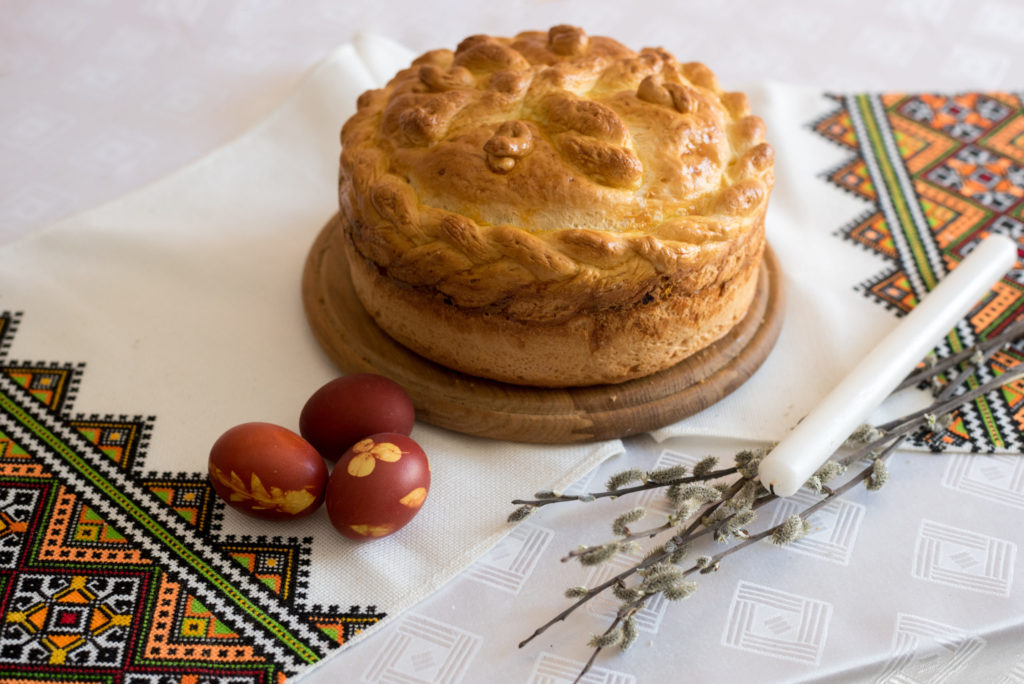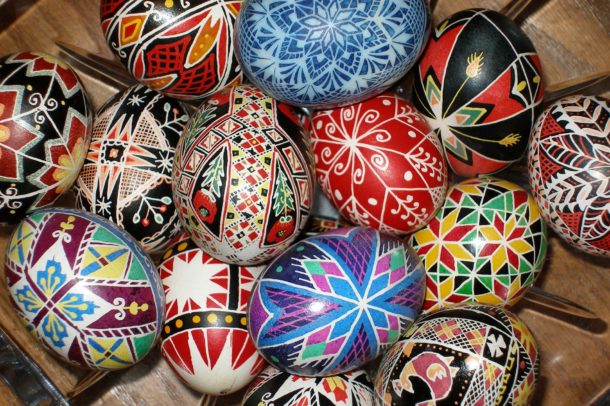Submitted by Dierdre Neuman, Nutrition Student, and Dani Renouf, RD, MSc, CDE
Image by Alisa Mizikar from Pixabay
Xристос Воскрес!
During Good Friday, Ukrainians will fast to honour Christ’s crucifixion- strictly no meat or dairy is to be consumed, no manual labour is allowed, and all conversation must be quiet. Pysanky (Ukraine’s famous decorated eggs) are prepared along with a basket that is to be blessed with holy water. The fast is broken on Sunday morning following Divine Liturgy in celebration of Christ’s resurrection – hence hearty foods such as eggs, butter, meats, cheeses, and salt are consumed in good vigor. Bread must be baked with pure thoughts, which represent the body of Christ, and pussy willows are picked in Canada to represent the palms laid down at Christ’s feet.
Easter brunch is one of the most looked-forward-to meals in Ukrainian culture, and those on a renal diet don’t have to worry much about missing out on their family tradition. Limit the use of processed and packaged foods, such as deli meats, ready-made sauces and gravies, and ready-to-eat snacks. Remember to plan your brunch ahead of time and consult a dietitian for meal planning on a renal diet.
Here are some suggestions for enjoying Easter brunch:
- Limit baked ham and kielbasa consumption or replace with baked fish.
- Limit adding salt to your food.
- Consult a dietitian to find out which cheeses are OK to eat on a renal diet.
- Egg whites are an excellent source of protein and can be enjoyed based on your protein requirements. Speak to your dietitian about how much protein is recommended for you.
Paska is a traditional Easter Bread.
Paska for the Whole Family recipe (from ukrainianclassickitchen.ca)
3 cups milk, scalded
1 package saffron (3/4 to 1 ounce) OR ½ – 1 tsp turmeric
1/4 cup boiling water (for the saffron)
2 packages of dry yeast (2 tablespoons)
3 Tbsp. sugar
1 1/2 cups lukewarm water
1 cup unsalted butter, room temperature
2/3 cup sugar
6 eggs, separated
1 1/2 tsp. salt
10 cups sifted flour (wholewheat preferred)
Juice and grated rind of 1 lemon
1 tsp. vanilla
Scald the milk and let cool to lukewarm. Pour ¼ cup boiling water over saffron; let it steep till cool, then strain.
Dissolve dry yeast and 3 Tbsp. sugar in 1 1/2 cups lukewarm water; cover and place in a warm place for 10 minutes.
Cream butter with remaining 2/3 cup sugar; add 6 egg yolks, one at a time, blending each in until thoroughly mixed. Add salt, lemon juice and grated rind, and cooled saffron water to a creamed mixture. Add yeast mixture and lukewarm milk to a creamed mixture, mixing well. Add 5 cups of sifted flour to a liquid mixture, mixing well. Beat the 6 egg whites until they stand in stiff peaks; fold into the dough mixture. Cover bowl and let dough rise in a warm place until doubled in bulk.
Add remaining sifted flour to make a soft dough that can be kneaded. Knead until smooth and elastic (and small blisters should appear under the skin of the dough and dough should not stick to your hands) on a floured board. Place dough in a greased bowl, cover with a clean dish towel and a bath towel, and set in a warm place to rise until doubled in bulk. Punch down the dough to release the air. Reserve 1/8 to 1/4 of the dough for decorating, and shape remaining dough into 2 or 3 loaves. Place in well greased round bread pans. Cover and let rise until doubled in bulk. Decorate as desired with reserved dough before baking. Bake in a preheated 325 F. oven for 30 minutes, then reduce oven heat to 275 F. and bake an additional 35 minutes longer. Brush tops with egg beaten with a little milk and return to the oven to bake 5 more minutes or until golden and shiny. Serve with butter and honey.

ADDITIONAL NOTES: sprinkle sesame seeds on top before baking to add texture and fiber to the bread. Raisins, cranberries, hemp seeds, or pumpkin seeds, and flax can be added to the dough for added micronutrients and fiber.
This recipe is high in carbohydrates, especially for people with diabetes. Enjoy this Easter tradition in moderation.
Nutritional Analysis:
Based on 24 servings
Calories 324 Kcal
Protein 8.4g
Carbohydrate 49.7g
Fibre 1.9g
Sodium 180.5 mg
Phosphorus 115.02 mg
Potassium 145.97 mg
Renal and Diabetic Exchange
1 Protein Choice and 3 Carb Choices
